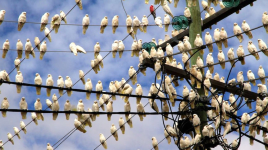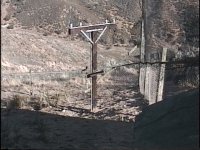jurek
Well-known member
I recently saw a presentation that electrocution on electricity poles is the major reason of deaths of Bald Ibis in Europe. Electrocution kills also White Storks, all birds of prey, owls, and many other bird species. I realized that it is a direct bird protection which has obvious emotional appeal to laypeople, because it helps individual birds, not just species. And it is not an obvious competition to other conservation. But bird protection societies are almost silent about it. So a sort of an empty niche in bird protection.
One danger is short-circuiting of larger birds landing on poles, which kills many large and charismatic species. I saw a film showing a young White-tailed Eagle landing on a pole and immediately dropping dead. This can be prevented by fitting the poles with isolation. Second danger are collisions of flying birds, which are probably more spread across the landscape, but can be prevented locally e.g. by installing visible markings. For large, slower breeding birds, it can be a major mortality factor, and can make the difference between population going extinct or recovering.
It turns, that electricity companies are often sympathetic to insulating electricity poles, because it reduces costly power outages. In Poland, a big success was collaboration between local bird societies and electricity companies, where the company staff moved stork nests to metal supports raised above the electrified wires. I also heard that fitting electricity poles with isolation to make them bird safe is mandatory in Germany but not other countries.
Any thoughts about this?
Any moves from local bird reserves to make electricity poles around the reserves safer for birds?
Any big moves from bird protection societies to start collaboration with electricity companies in their area?
Any even bigger campaigns to make bird-friendly power lines mandatory by law?
Any other campaigns to make electricity poles bird safe e.g. on migration hotspots?
One danger is short-circuiting of larger birds landing on poles, which kills many large and charismatic species. I saw a film showing a young White-tailed Eagle landing on a pole and immediately dropping dead. This can be prevented by fitting the poles with isolation. Second danger are collisions of flying birds, which are probably more spread across the landscape, but can be prevented locally e.g. by installing visible markings. For large, slower breeding birds, it can be a major mortality factor, and can make the difference between population going extinct or recovering.
It turns, that electricity companies are often sympathetic to insulating electricity poles, because it reduces costly power outages. In Poland, a big success was collaboration between local bird societies and electricity companies, where the company staff moved stork nests to metal supports raised above the electrified wires. I also heard that fitting electricity poles with isolation to make them bird safe is mandatory in Germany but not other countries.
Any thoughts about this?
Any moves from local bird reserves to make electricity poles around the reserves safer for birds?
Any big moves from bird protection societies to start collaboration with electricity companies in their area?
Any even bigger campaigns to make bird-friendly power lines mandatory by law?
Any other campaigns to make electricity poles bird safe e.g. on migration hotspots?







